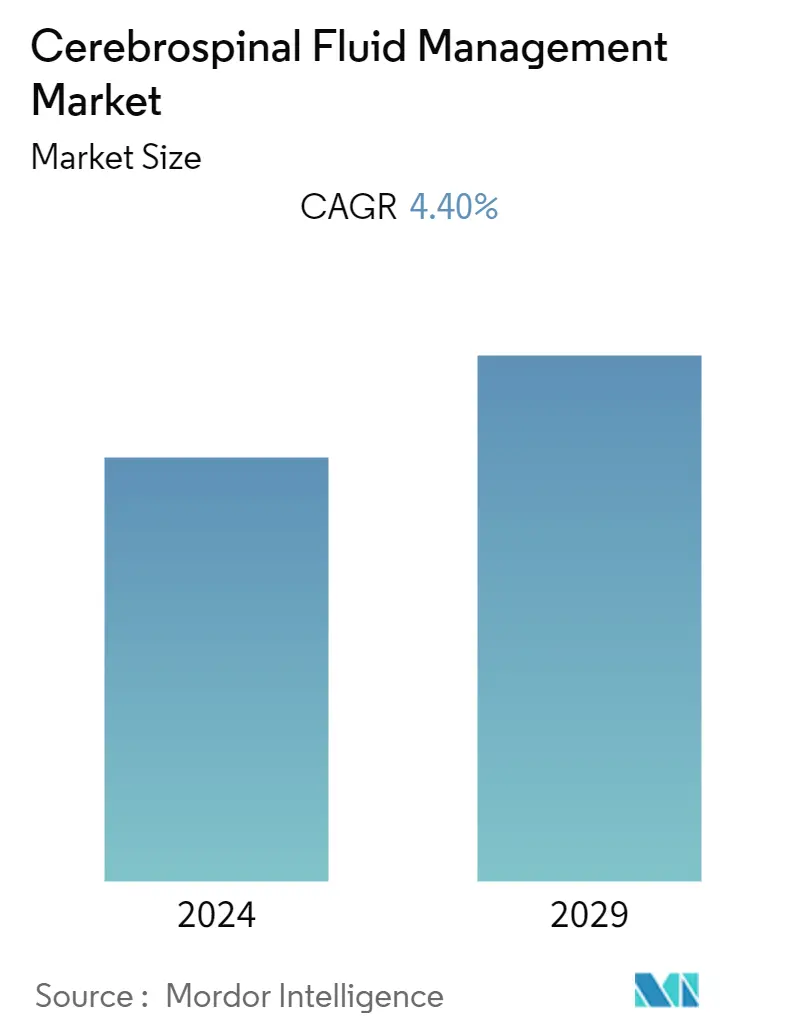Market Size of Cerebrospinal Fluid Management Industry

| Study Period | 2019 - 2029 |
| Base Year For Estimation | 2023 |
| CAGR | 4.40 % |
| Fastest Growing Market | Asia Pacific |
| Largest Market | North America |
| Market Concentration | Low |
Major Players
*Disclaimer: Major Players sorted in no particular order |
Cerebrospinal Fluid Management Market Analysis
The cerebrospinal fluid management market is expected to register a CAGR of 4.4% over the forecast period.
- COVID-19 had a profound impact on the cerebrospinal fluid management market owing to the cancellations in elective procedures, including treatment and diagnosis of neurological disorders worldwide, impacting the studied market. For instance, according to a World Health Organization (WHO) survey that 155 countries completed over three weeks in May 2020, more than half of the countries surveyed had services for noncommunicable diseases and emergencies, such as various neurological disorders, partially or entirely disrupted. However, the market has been recovering since restrictions were lifted, and government and healthcare organizations put efforts to clear the backlog of treatments caused by the pandemic.
- In addition, the increasing burden of hydrocephalus and other neurological disorders and growing adoption of minimally invasive solutions, and the rising geriatric population are actively affecting the growth of the studied market.
- According to an article published in StatPearls in July 2022, the overall global prevalence of hydrocephalus is roughly 85 per 100,000 individuals, with a significant difference between different age groups. It also stated that the global prevalence is 88 per 100,000 individuals for the pediatric population and 11 per 100,000 individuals for adults.
- According to the same source, due to the high occurrence of normal pressure hydrocephalus (NPH) later in life, the prevalence of hydrocephalus in the elderly population is substantially greater, around 175 per 100,000 people, and more than 400 per 100,000 people for those over 80 years old. The same source reported that Africa and South America have higher hydrocephalus prevalence. Thus, the high prevalence of hydrocephalus worldwide is estimated to propel the market growth during the forecast period.
- Also, as per the article published by the national library of medicine in September 2021, the pooled incidence of congenital hydrocephalus was highest in Africa and Latin America (145 and 316 per 100,000 births, respectively) and lowest in the United States/Canada (68 per 100,000 births). Thus, the high burden of hydrocephalus worldwide is driving the market growth.
- Product launches by key players worldwide are projected to fuel market growth. For instance, in December 2021, Boston-based CereVasc launched the eShunt as the first minimally invasive cerebrospinal fluid shunt. It aims to replace the need for invasive surgery and prolonged hospitalization that come with the current surgical treatment of hydrocephalus. The product launches are estimated to propel the market growth.
- However, a lack of awareness and the dearth of skilled professionals are anticipated to hinder market growth.
Cerebrospinal Fluid Management Industry Segmentation
As per the report's scope, cerebrospinal fluid management involves using medical devices such as shunts and external fluid drainage systems to drain excess fluid from the brain.
The cerebrospinal fluid management market is segmented by products (shunts (by valve (adjustable valve shunts, monopressure valve shunts), by type (ventriculoperitoneal shunts, ventriculoatrial shunts, lumboperitoneal shunts, ventriculopleural shunts)), and external vascular drainage devices), and geography (North America, Europe, Asia-Pacific, Middle East and Africa, and South America). The market report also covers the estimated market sizes and trends for 17 countries across major global regions.
The report offers the value (in USD million) for the above segments.
| By Products | ||||||||||||
| ||||||||||||
| External Vascular Drainage Devices |
| By Geography | ||||||||
| ||||||||
| ||||||||
| ||||||||
| ||||||||
|
Cerebrospinal Fluid Management Market Size Summary
The cerebrospinal fluid management devices market is poised for steady growth, driven by the increasing prevalence of hydrocephalus and neurological disorders, alongside the rising adoption of minimally invasive solutions. The market experienced disruptions due to the COVID-19 pandemic, which led to the cancellation of elective procedures and a backlog in treatments. However, recovery has been underway as restrictions eased and efforts were made to address the treatment backlog. The growing geriatric population and the high global prevalence of hydrocephalus, particularly in regions like Africa and South America, are significant factors propelling market expansion. Product innovations, such as minimally invasive shunt technologies, are expected to further stimulate market growth, despite challenges like limited awareness and a shortage of skilled professionals.
North America is anticipated to be a significant growth region, supported by a robust healthcare infrastructure, increased awareness of treatment options, and substantial research and development investments. The high incidence of neurological conditions, such as strokes, and strategic initiatives by healthcare institutions are contributing to market expansion. The competitive landscape is characterized by a mix of international and regional players, with key companies like Medtronic Plc and B. Braun Melsungen AG holding significant market shares. Ongoing research and development efforts, including grants and collaborations, are expected to drive innovation and enhance the utility of cerebrospinal fluid management devices, further propelling market growth during the forecast period.
Cerebrospinal Fluid Management Market Size - Table of Contents
-
1. MARKET DYNAMICS
-
1.1 Market Overview
-
1.2 Market Drivers
-
1.2.1 Increasing Burden of Hydrocephalus and Other Neurological Disorders
-
1.2.2 Growing Adoption of Minimally Invasive Solutions and Rising Geriatric Population
-
-
1.3 Market Restraints
-
1.3.1 Lack of Awareness of Treatment Options and Dearth of Skilled Professionals
-
-
1.4 Porter's Five Forces Analysis
-
1.4.1 Threat of New Entrants
-
1.4.2 Bargaining Power of Buyers/Consumers
-
1.4.3 Bargaining Power of Suppliers
-
1.4.4 Threat of Substitute Products
-
1.4.5 Intensity of Competitive Rivalry
-
-
-
2. MARKET SEGMENTATION (Market Size by Value - USD Million)
-
2.1 By Products
-
2.1.1 Shunts
-
2.1.1.1 By Valve
-
2.1.1.1.1 Adjustable Valve Shunts
-
2.1.1.1.2 Monopressure Valve Shunts
-
-
2.1.1.2 By Type
-
2.1.1.2.1 Ventriculoperitoneal (VP) Shunts
-
2.1.1.2.2 Ventriculoatrial (VA) Shunts
-
2.1.1.2.3 Lumboperitoneal (LP) Shunts
-
2.1.1.2.4 Ventriculopleural (VPL) Shunts
-
-
-
2.1.2 External Vascular Drainage Devices
-
-
2.2 By Geography
-
2.2.1 North America
-
2.2.1.1 United States
-
2.2.1.2 Canada
-
2.2.1.3 Mexico
-
-
2.2.2 Europe
-
2.2.2.1 Germany
-
2.2.2.2 United Kingdom
-
2.2.2.3 France
-
2.2.2.4 Italy
-
2.2.2.5 Spain
-
2.2.2.6 Rest of Europe
-
-
2.2.3 Asia-Pacific
-
2.2.3.1 China
-
2.2.3.2 Japan
-
2.2.3.3 India
-
2.2.3.4 Australia
-
2.2.3.5 South Korea
-
2.2.3.6 Rest of Asia-Pacific
-
-
2.2.4 Middle East and Africa
-
2.2.4.1 GCC
-
2.2.4.2 South Africa
-
2.2.4.3 Rest of Middle East and Africa
-
-
2.2.5 South America
-
2.2.5.1 Brazil
-
2.2.5.2 Argentina
-
2.2.5.3 Rest of South America
-
-
-
Cerebrospinal Fluid Management Market Size FAQs
What is the current Cerebrospinal Fluid Management Market size?
The Cerebrospinal Fluid Management Market is projected to register a CAGR of 4.40% during the forecast period (2024-2029)
Who are the key players in Cerebrospinal Fluid Management Market?
Medtronic Plc , Integra Lifesciences (Arkis BioSciences), Natus Medical Incorporated , Sophysa and B. Braun Melsungen AG are the major companies operating in the Cerebrospinal Fluid Management Market.

